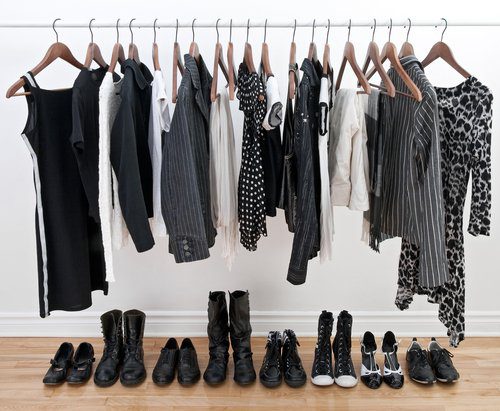
The term “capsule wardrobe†has been circling around on the internet for the past few years. A capsule wardrobe is essentially creating a wardrobe of versatile items that you absolutely LOVE, rather than having a large wardrobe filled with pieces you kind of like and occasionally wear. If you’ve ever looked at your closet, filled with clothes, and felt like you have absolutely nothing to wear, a capsule wardrobe is probably exactly what you need.
Cleaning out your closet
The first step to creating your capsule wardrobe?
- Clean out your closet!
- Sort your clothes into four different piles.
The first pile is for clothing that you absolutely love, it fits right, and you would wear it right this instant. These are the staples of your wardrobe that are constantly on repeat. The second section is for stuff you don’t really want to get rid of, but you never really wear. Clothes that don’t fit right, you don’t have anything that goes with them, etc. Put these ones in a box in your garage or top shelf of your closet. If you don’t pull something out of that box during a season, get rid of the whole box. The third pile of clothes are clothes you never wear and are ready to get rid of. Try donating them or selling them to a preloved clothing exchange store. If you’re able to sell any of your clothes, save this money for when you’re ready to replenish your wardrobe. And the last pile of clothes will be for seasonal items. You don’t wear a wool sweater during July, but you love it in December, so you don’t want to get rid of these items.

Different wardrobes for different seasons
A lot of people recommend having four capsule wardrobes that you swap items in and out of as the seasons change. Some items will stay the same, your very favorite pieces that are versatile. But everything else will get stored until that season comes back around.
Some people find it helpful to have a number to aim for. This way you’re limited from filling your closet with new clothes you never wear again. Take a while to wear JUST the items that you love. As you go about wearing just these things, you’ll realize that there are pieces you’re missing or that you need. Once you’re comfortable in your smaller wardrobe, go out and purchase the pieces you feel like you definitely need. Since shopping for an entire new wardrobe can get expensive, you may want to shop at a clothing exchange store, or just shop the clearance section. Don’t let searching for deals lower your standards, though. In the end, aim for around 37 total pieces of clothing in your wardrobe (including shoes) each season.
Try to aim for nine pairs of shoes, nine bottoms, 15 tops, and then fill in the other four spaces with dresses or jackets, depending on the season. For your nine shoes, it’s smart to try for three pairs of flats, three pairs of heels, and three pairs of boots. For nine bottoms, that’s three pairs of pants/jeans, three pairs of shorts, and three skirts. This means that in each section of three, you can have an option that’s casual, a statement piece, and a piece that’s kind of in-between.

How to change for the seasons
At the end of a season, go through what’s in your wardrobe, and decide what you’ll be able to wear in the coming months. For example, going from summer to fall, you may want to pack up your sandals and tank tops. Then you’ll fill in the gaps with new items (or items from past seasons, after you’ve had a capsule wardrobe for over a year,) until you reach your desired number of items.
If you purchase an item for your capsule wardrobe and you find yourself rarely wearing it, that’s okay! Wait until the end of the season, and if you still find that you haven’t fallen in love with it, get rid of that item, and then you can purchase something new to replace it next year.
You can also check out this interview for some fabulous wardrobe tips as we talked style with E’Beth Goad.
Article originally published Sept 3, 2017.

 Do you want to join a fun, supportive group of women? Come on over to our supportive, loving and fun facebook group. Mamas and Coffee® is all about the REAL of womanhood. Join Us.
Do you want to join a fun, supportive group of women? Come on over to our supportive, loving and fun facebook group. Mamas and Coffee® is all about the REAL of womanhood. Join Us.
- What Are The Types of Stroke - November 22, 2025
- What is Carotid Artery Thrombosis? - November 17, 2025
- When Words Won’t Cooperate After a Stroke - November 14, 2025
